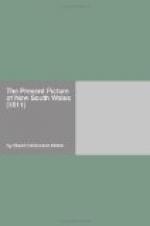In View, No. II. taken from the West side of the Cove, the lofty House of which a part is seen, and which was spoken of in No. II. of the other Views, and I. of this, belongs to Mr. Isaac Nichols; and the buildings on this side are the back of the General Hospital. The Bridge, the only one built of stone in the whole colony, is a very bad structure; the walls on each side of the arch inclose the grounds belonging to the Orphan-house and Mr. Simeon Lord. The road seen on the other side of the bridge is called Spring-row; it leads to several streets, and joins the main road to Parramatta, etc.; below the paling of which there are very large Tanks, cut in rocks, to supply the town and shipping with water; but there is another watering-place for ships on the north side of the Cove, very commodious, and the permission to use which produces a small annual income to the Orphan fund. The rows, commencing above the foot of the Bridge, on the east side, are called Chapel, Pitt’s, and Serjeant-Major’s rows, the latter of which, under the two birds, runs to the Brick-fields, towards Parramatta. The House on the right, at this end of the longest street, seen in this View, with three windows and a door visible, belongs to Garnham Blaxcell, Esq. spoken of in No. I. of the other Views. The building, the eastern end of which is partly covered by a tree, is the most southern Military Barrack. The two lofty red houses at the west foot of the Bridge, in the rise, are side-views of the Orphan-house and Mr. James Underwood’s, spoken of in No. I. of the other Views. The houses on the right, a spot called the Rocks, belong to different individuals, and some of them are very comfortable habitations.
Over the south creek at Hawkesbury a floating-bridge has been erected, which has proved greatly beneficial to the public; since, previous to its completion, every person who had occasion to go to that settlement, and in many cases from one farm to another, was obliged to pass to and fro in a boat. As this bridge was constructed by an individual (Mr. Andrew Thompson, a settler) at his own expense, the following tolls are allowed to be demanded:—For every foot-passenger, four-pence, or ten shillings per annum; for each horse, single or in draught, two shillings and sixpence, or two pounds ten shillings per annum; for waggons, or other four-wheel carriages, with not more than half a ton lading, one shilling and sixpence, or one pound ten shillings per annum; for carts, or carriages with two wheels, laden or not, each one shilling and sixpence, or one pound ten shillings per annum; for sheep, under a score, two-pence each, and by the score two shillings and sixpence, or two pounds ten shillings per annum; swine and goats, the same as sheep. Passengers, horses, carts, and carriages, are allowed to pass and re-pass, during the same day, with one ticket; and a considerable income is derived from this toll.
* * * * *
The children born in this colony from European parents, are very robust, comely, and well made; nor do I recollect a solitary instance of one being naturally deformed. They are remarkably quick of apprehension; learn any thing with uncommon rapidity; and greatly improve in good manners, promising to become a fine race of people.




